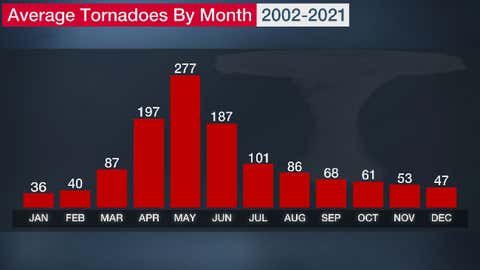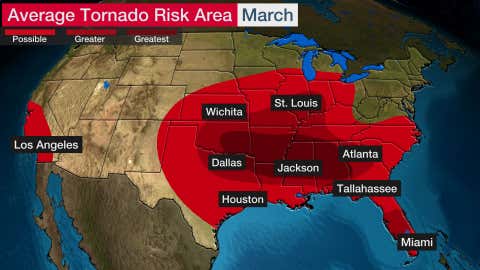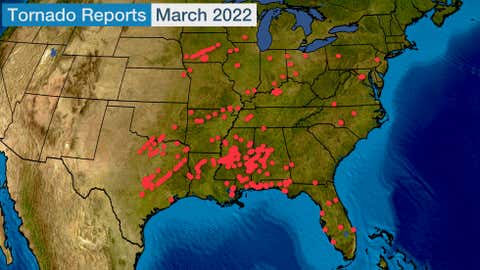
At a Glance
- Severe thunderstorms and tornadoes usually become more widespread beginning in March.
- They're still most likely in the South, but can also spread into the Plains and Midwest.
- A record March tornado count occurred from three outbreaks in 2022.
- There have been other significant March outbreaks in recent years.
Sign up for the Morning Brief email newsletter to get weekday updates from The Weather Channel and our meteorologists.
In March, severe thunderstorms and tornadoes usually become more numerous and widespread, beginning the climb toward the nation's spring peak. Recent Marches, however, have been among the most active months of the year.
This may be disconcerting for those who have been plagued with recent severe weather, including tornadoes and damaging winds in the Southern Plains on Feb. 26.
Here's what you need to know:
March tornadoes usually double from February: Over the last 20 years, an average of 87 tornadoes have occurred in the U.S. each March.
While that's only the fifth most active month, it's more than double the average from February, and it kicks off the annual ramp-up of tornado counts in the U.S. toward the peak in May.

March tornadoes are usually spawned in the South: Typically in March, the peak tornado threat is still in the South, from Alabama westward into Mississippi, Arkansas and Louisiana. That's not much different from the peak threat area in winter.
However, in March, this increased tornado risk also expands westward, encompassing more of Oklahoma and Texas.

But areas farther north can have March tornadoes: As you can see in the map above, the tornado risk also expands northward into the central Plains and Midwest in March.
Last March 5, a 70-mile-long tornado rated EF4 tore across central Iowa, claiming six lives. A March 6, 2017, EF1 tornado was Minnesota's farthest north so early in the year, accompanying an outbreak that also spawned an EF3 tornado in Oak Grove, Missouri.
Widely considered the worst tornado in U.S. history, the "Tri-State Tornado" carved a path from Missouri to Illinois and Indiana on March 18, 1925, and killed 695 people.

Here's why severe weather ramps up in spring: In early spring, the jet stream is still strong, owing to the still-sharp temperature contrast across the country between lagging winter cold and building warmth.
Increasingly in March, warmer and more humid air is in place over the South more often and is occasionally pulled farther north into the Plains and Midwest.
This volatile mix of ingredients can ignite severe thunderstorms and tornadoes.
Recent Marches have been hyperactive: In March 2022, 236 tornadoes were documented in the U.S., the most for any March dating to 1950. That was due to three separate outbreaks – March 5-6, March 21-22 and March 30-31. Among the hardest-hit areas last March were central Iowa (March 5), Jacksboro, Texas (March 21), and Arabi, Louisiana (March 22).
March 2021 had about 100 fewer tornadoes than 2022. But mid- and late-month outbreaks included destructive tornadoes in the southern Birmingham metro area as well as the Newnan, Georgia, late-night EF4 tornado on March 25.

But some Marches have been much quieter: From 2013 through 2015, no more than 20 tornadoes were documented in the entire month of March.
Those Marches each were generally colder than average in the central and eastern U.S., the opposite of the pattern most favorable for severe thunderstorms.
Here is what you can do: For those who haven't experienced winter severe thunderstorms, this seasonal change may seem sudden.
Now is the time to review or develop a severe weather plan. Know where to take shelter if you receive a tornado warning and have multiple ways of receiving warnings, including NOAA weather radio and a smartphone app.
Planning ahead could save your life the next time severe weather strikes.
The Weather Company’s primary journalistic mission is to report on breaking weather news, the environment and the importance of science to our lives. This story does not necessarily represent the position of our parent company, IBM.



